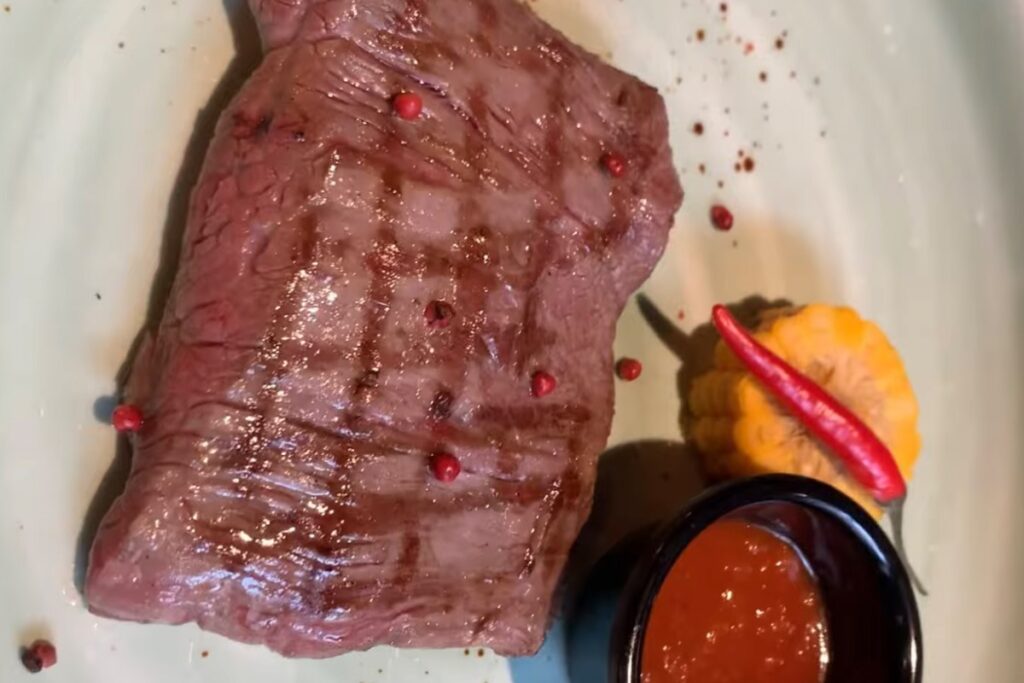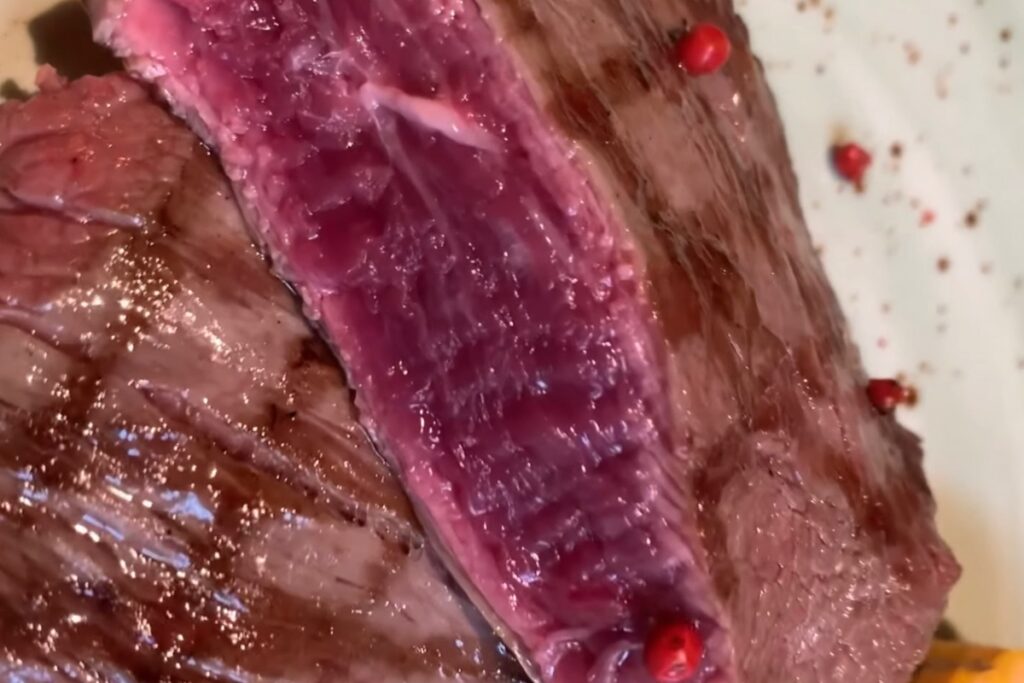What Is Blue Steak?
A blue steak is cooked for only 1 minute on both sides, and then it is served. Because the inside remains raw, the steak is only placed on the grill for a round 1 minute, and the internal temperature rarely exceeds 115℃.
As famous chef Gordon Ramsay once said: Blue steak is named blue because when it is fresh, raw meat has a slight purple/blue-ish hue. This is due to depleted oxygen-residual blood within the meat.

Blue isn’t as permanent as people think. When meat is exposed to air, myoglobin becomes oxygenated, turning red. This means that if you’re not there when your steak is being cut, you won’t be able to see the blue coloring.
Eating Blue Steak: Is it Safe?
There is a common misconception that eating blue steak is outrageously unsafe because it’s almost raw. That’s not true. Blue steak isn’t always raw or dangerous.
It’s perfectly safe if you sear the edge and cook the rest of the steak. The reason why is really simple. Bacteria are more likely to cover a steak when it’s raw.
But once you sear the steak, the bacteria is stuck to the outside and can’t get inside.
Steak is a very delicious meat that is always cooked well done or rare. Most of the time, there is no need to worry about getting sick after eating a cooked steak because it is perfectly safe.
What You Need To Cook A Blue Steak?
Filet Mignon or Sirloin steak should be used for the following guide. Tender, high quality meat will be cooked evenly by the cast iron skillet. Fat will not have enough time to cook, so stay away from fatty cuts.
- High smoke point oil: Use grapeseed, peanut, or canola oil.
- Seasonings: Salt and pepper. We want to create a nice crust and seal out the edges of the steak. Be sure to season your steak evenly. You can add some garlic cloves for more flavor. Our favorite method of cooking steaks is searing them over high heat until the meat starts to brown.
- Then, move the pan to medium heat and let the steak cook for about 5 minutes per side.
- Afterward, remove the steak from the pan and place it on a plate.
- Let it rest for 10 minutes before slicing. Tongs should be made out of stainless steel or aluminum. Silicon coated tongs are hard to clean and bacteria can stick to them. We suggest having multiple pairs of tongs available. To sanitize your tongs, simply wash them in warm water with soap. Then rinse them thoroughly with hot water. Do not use Clorox Wipes!
How To Cook A Blue Steak
Bring the meat to room temperature first. Remove it from the fridge at least 15 minutes ahead of cooking time. Cook it over high heat until medium rare. Paper towels can be used to pat the meat, drying it out so that it doesn’t absorb water.
Salt and pepper should then be added to season the meat. Thankfully, the cooking time is typically short, so make sure your pan is hot before putting the steak in.
Just don’t overcook the steak because it will lose its juiciness. A steak should be cooked over medium-high heat for about 1 minute per side.
You should use a timer to make sure you don’t overcook your steak. After cooking, allow the steak to rest for 10 to 15 minutes before serving.
What Kind Of Cut Should You Choose To Get The Best Blue Steak?
Steak cuts are very diverse, but there is one thing that they all share. Fat will be rendered out when cooking steaks normally, but when eating them blue, the fat will stay intact.
This means that some cuts are better than others. Blue steak is the least desirable because the fat stays inside. Sirloins and flanks are both great cuts of beef.
They are also flavorful and low-marbled. Cooked well, they taste delicious.
Things To Keep In Mind
Blue steaks are delicious because they taste better than red ones. You should always cook them on the outside but not inside. To make sure that you don’t contaminate the meat, use clean tongs to flip the steak over.
Extra Tips

The color of good quality beef should be brilliant red, indicating that it is still fresh. Avoid eating fatty meats like bacon or pork belly. Before cooking, allow the steak to come to room temperature for an hour.
To keep hazardous bacteria at bay, you’ll need a trustworthy instant-read thermometer and sanitizing gear. For optimal results, cook this meal on a hot iron skillet.
Searing the outside of the steak won’t completely eliminate foodborne bacteria, but it will assist to reduce them. Your steak should be resting on a bed of seasoned butter. Before serving, let the butter melt into the meat.
For added flavor, we recommend serving your steak with blue cheese.
Nutritious Effects Of Rare Blue Steaks
If you’ve been hearing a lot about how important steak is in our diet for a long time, you might be wondering if it’s actually good for you.
So, how nutritious is steak? Whether you like steak or not, we can all agree that meat has a range of nutritional benefits. Let’s take a closer look at why steak is a healthy food option.
Foods That Are High In Protein
Steak is a high-protein food, and protein is required by virtually all of your body’s cells. Because it’s a macronutrient, your body needs a lot of it to run smoothly. Hair, skin, nails, cartilage, bones, and blood all require protein to operate properly.
It’s required for muscle growth and tissue healing, as well as hormone, enzyme, and other substance production in the human body.
Steak is a great way to up your protein consumption, and each 100 gram serving of porterhouse, sirloin, or T-bone contains around 176 calories and 20 grams of protein.
Iron Deficiency Can Be Avoided By Eating Steak
Iron is necessary for our bodies’ daily functions because it aids our red blood cells in delivering oxygen to our cells.
Steak is one of the best sources of iron, making it an excellent meal choice for anemia sufferers.
Red meat is not only abundant in iron, but it is also easily absorbed by the body. One serving of beef provides 15% of our daily recommended iron consumption, which ranges from 13.7 to 15.1 milligrams per day.
Other Vital Micronutrients Can Also Be Found In Steak
Aside from protein and iron, steak is high in other nutrients that our systems need, such as carnosine and creatine, which help our muscles and brains work normally.
In fact, it has been proved in the past that persons who do not consume meat are nutritionally inadequate.
Iron, B vitamins, selenium, and zinc are all abundant. Choose grass-fed steak over grain-fed steak if you want to boost your vitamin intake even further.
Final Thoughts
For diners looking for something extra rare, blue steak has become a trendy alternative to meat. Happy cooking!
- Is Blue Steak Safe To Eat? - May 7, 2022
- How To Tell If Your Bratwurst Sausage Is Cooked - May 7, 2022
- The Internal Temperature For Tri Tip When Done - May 7, 2022








